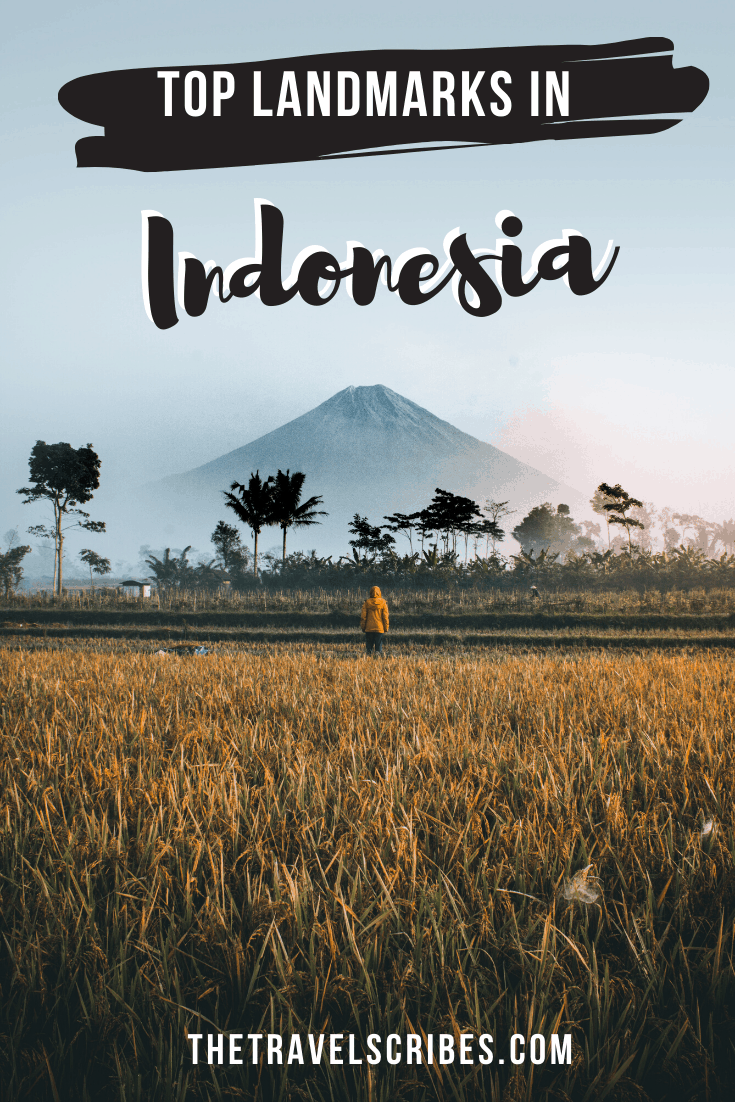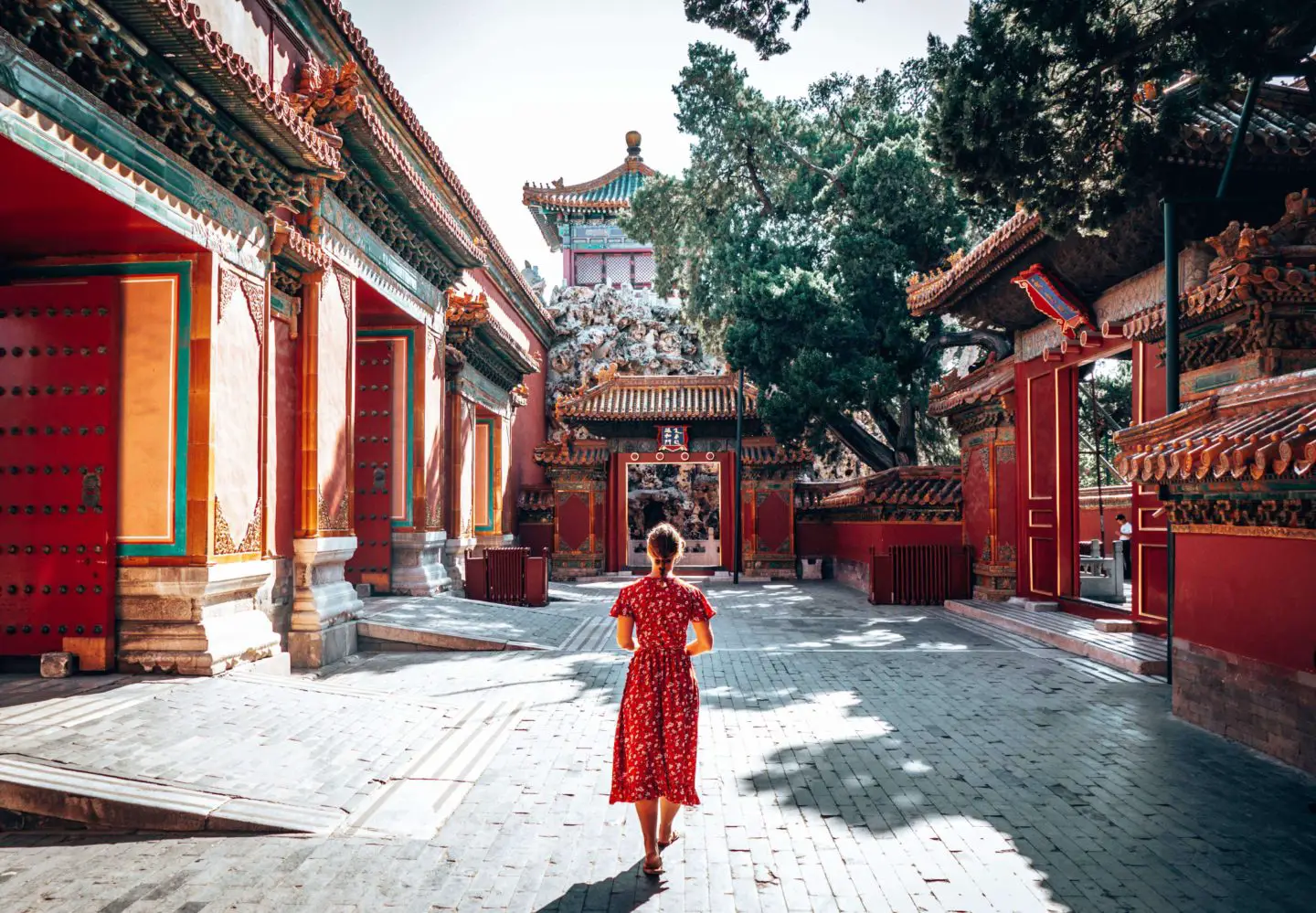The world’s largest island country, Indonesia is made up of over 17,000 islands, many of which offer their own unique experiences and beauty, so it’s not a surprise that Indonesia is absolutely littered with stunning and famous landmarks. You can hike an active volcano in East Java get close to Krakatoa in West Java, get lost in the buzzing streets of Jakarta, explore historic sites and temples galore, and dive in virtually untouched places like Raja Ampat, but we’ve asked our fellow travel bloggers to come up with the absolute must-see landmarks in Indonesia.
So read on to find out what are the places that you must visit when you travel to Indonesia! Remember it’s much more than just Bali…
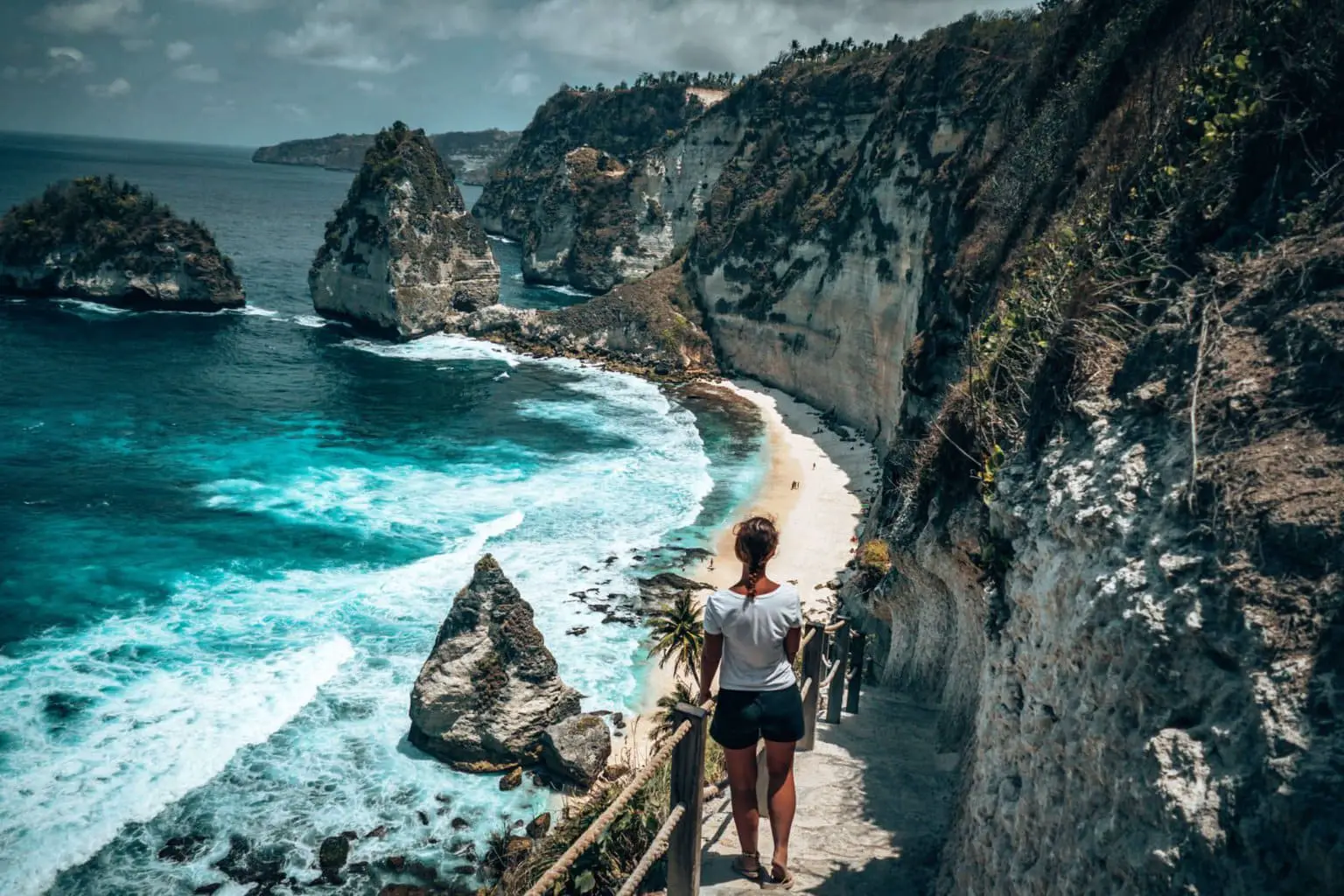
Skip ahead
Our top 10 landmarks in Indonesia
- Komodo National Park, East Nusa Tenggara
- Mount Bromo, East Java
- Kelingking Beach, Nusa Penida
- Mount Rinjani, Lombok
- Jatiluwih Rice Terraces, Bali
- Mount Ijen, East Java
- Borobudur Temple, Central Java
- Uluwatu Temple, Bali
- Sacred Monkey Forest Sanctuary, Bali
- Prambanan Temple, Central Java
Komodo National Park, Komodo, East Nusa Tenggara
Explored by Jackie & Justin from Life of Doing
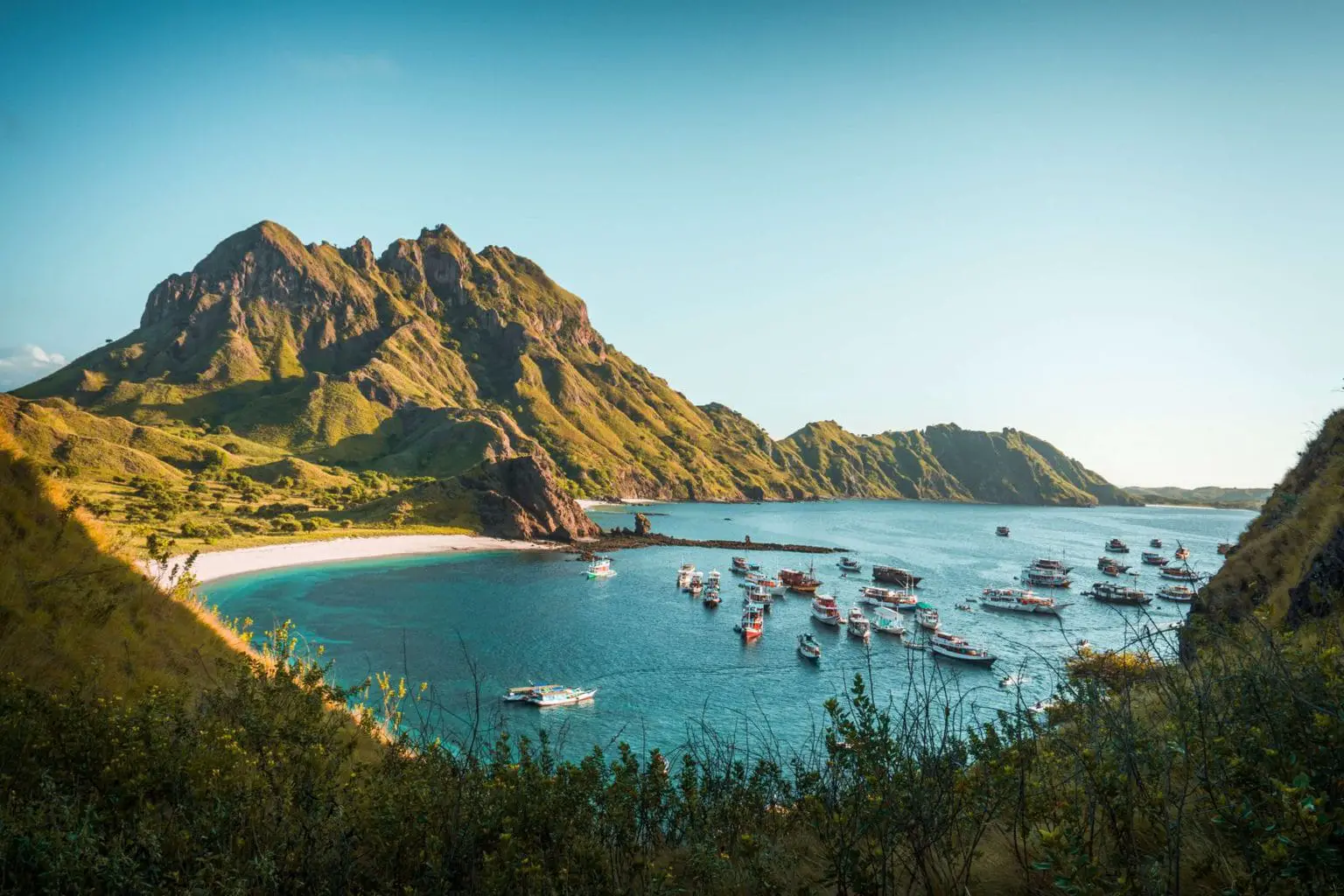
Located in the Flores area of Indonesia, Komodo National Park on Komodo Island is a special place to visit. It’s a UNESCO World Heritage site and the main attraction is seeing Komodo dragons, the giant carnivorous lizard. These prehistoric beasts can only be observed in the wild on 4 islands, Komodo, Rinca, Flores and Gili Motang. While the young dragons are adorable, the larger ones (which can grow to 3 metres in length) are intimidating. Watch them walk stealthily with their tongues sticking out to smell their prey. Although lucky for any one visiting, if they get too close, your guide will casually move them to another direction with a stick. Braver than us!
Besides visiting the Komodo dragons, Komodo National Park has other awesome adventures that you can do. If you’re spending one day at Komodo National Park, you should make sure to visit Padar Island for some stunning hiking, along with the Instagram famous pink beach. Padar Island has epic views of the turquoise lakes so definitely hike as high as you can. If you have 2 or more days, we’d recommend that you consider a liveaboard option to visit both Komodo and Rinca Islands as this affords the option to go snorkelling or diving with manta rays!
Borobudur Temple, Central Java
Explored by Lee from The Travel Scribes
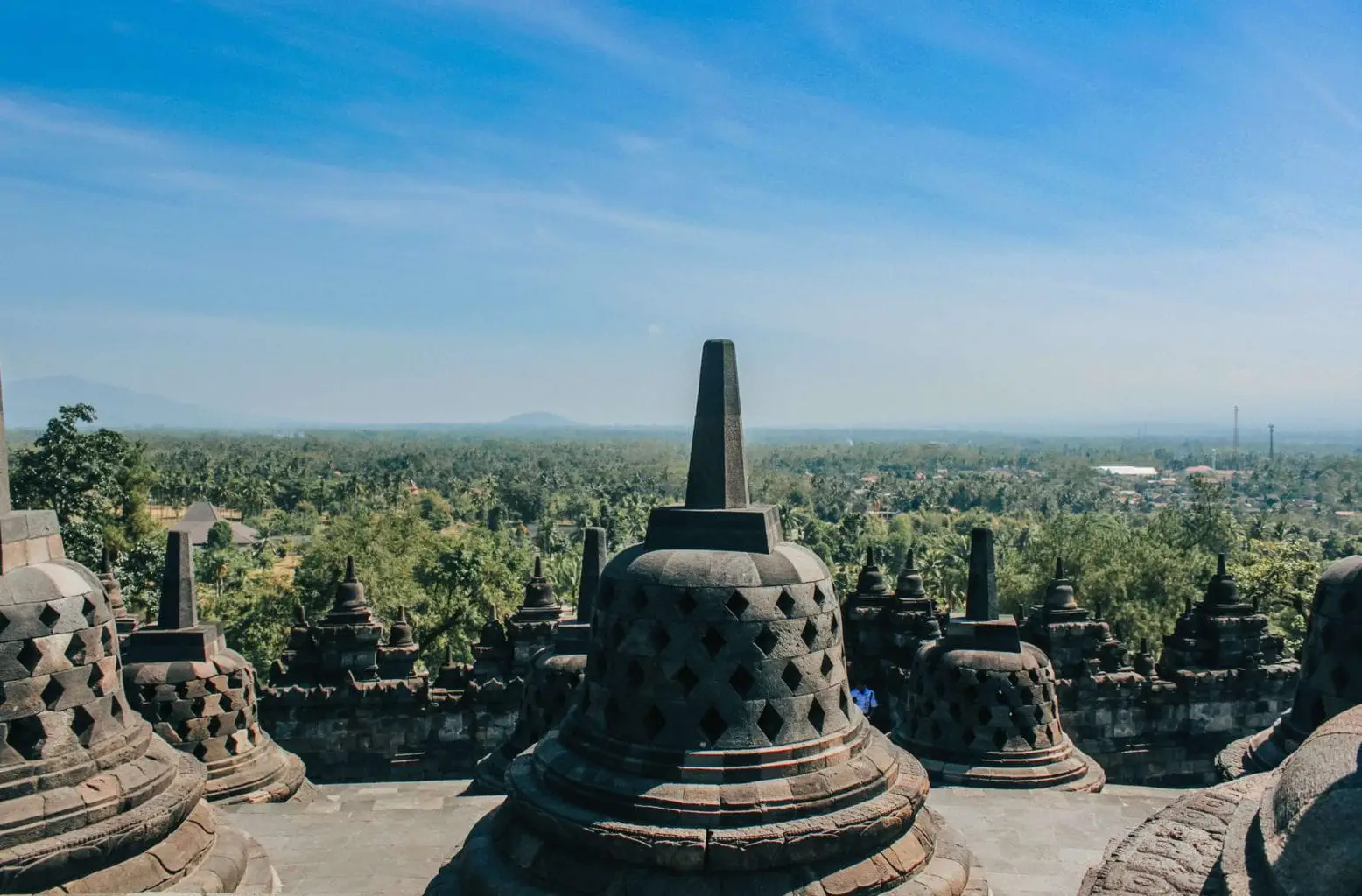
Tucked away in central Java is the world’s largest and possibly most impressive Buddhist temple, the ancient Borobudur temple. Often said to be one of the world’s seven wonders and so definitely on the list of landmarks in Indonesia, the temple was built in the 9th century during the reign of the Sailendra Dynasty but was actually ‘rediscovered’ in 1815 since it was entirely buried under a layer of volcanic ash!
The temple was restored in the 1970’s and is now a beautiful testament to the Buddhist religion. Made up of nine stacked columns (three circular and six square) with a central dome, it has over 2,500 relief panels and 72 buddha statues, all serenely seated inside a stupa. Essentially the place is a shrine to Buddha and pilgrims are meant to begin their ‘journey’ by following the base of the monument up to the top, reminiscent of the levels of Buddhist cosmology.
The best way to explore it? By foot. You don’t really need a guide and can spend your time strolling around and taking in this enormous area and taking in the scenery since the temple is sat atop a hill, overlooking beautiful leafy green fields. That said, if you want to delve deeper into the history, you can hire a guide on-site or pre-book one through Get your Guide. Doing a tour will also mean you get your transport out to the site – it’s about an hour from nearby Yogyakarta and the easiest way to get there is via a tour or a rental car.
The Equator Monument, Pontianak
Explored by Marya from The BeauTraveler
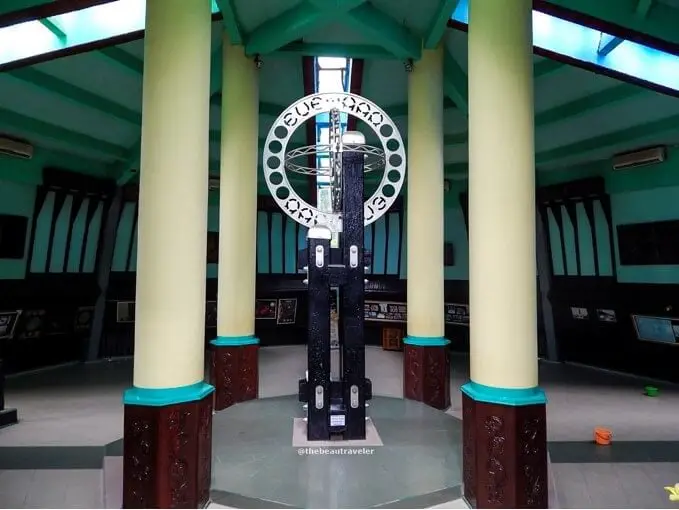
Apart from being known as the Equator city, Pontianak is also the home of the longest river in Indonesia, Kapuas River. Set in the capital city of West Kalimantan, the Equator Monument in Pontianak is something you can’t miss if you ever get to the city.
As you may already know, the Earth is divided by an imaginary line called the Equator and split it into the north and the southern hemisphere. Well, if you check Pontianak on the map, the city is located around the line and the Equator Monument is exactly on the 0° altitude.
When I saw this national monument for the first time, the monument didn’t actually seem so special. But if you’re interested to experience something different around the Equator, you can plan out your visit to the monument during the annual culmination point of the sun. During these days, you will experience the afternoon without any shade within the Equator line.
The culmination point of the sun takes place on either March 22 – 23 or September 21 – 23 every year.
Read next: Which landmarks make the list on the most iconic Sri Lanka landmarks?
Tanah Lot Temple, Bali
Explored by Kenny from Knycx Journeying
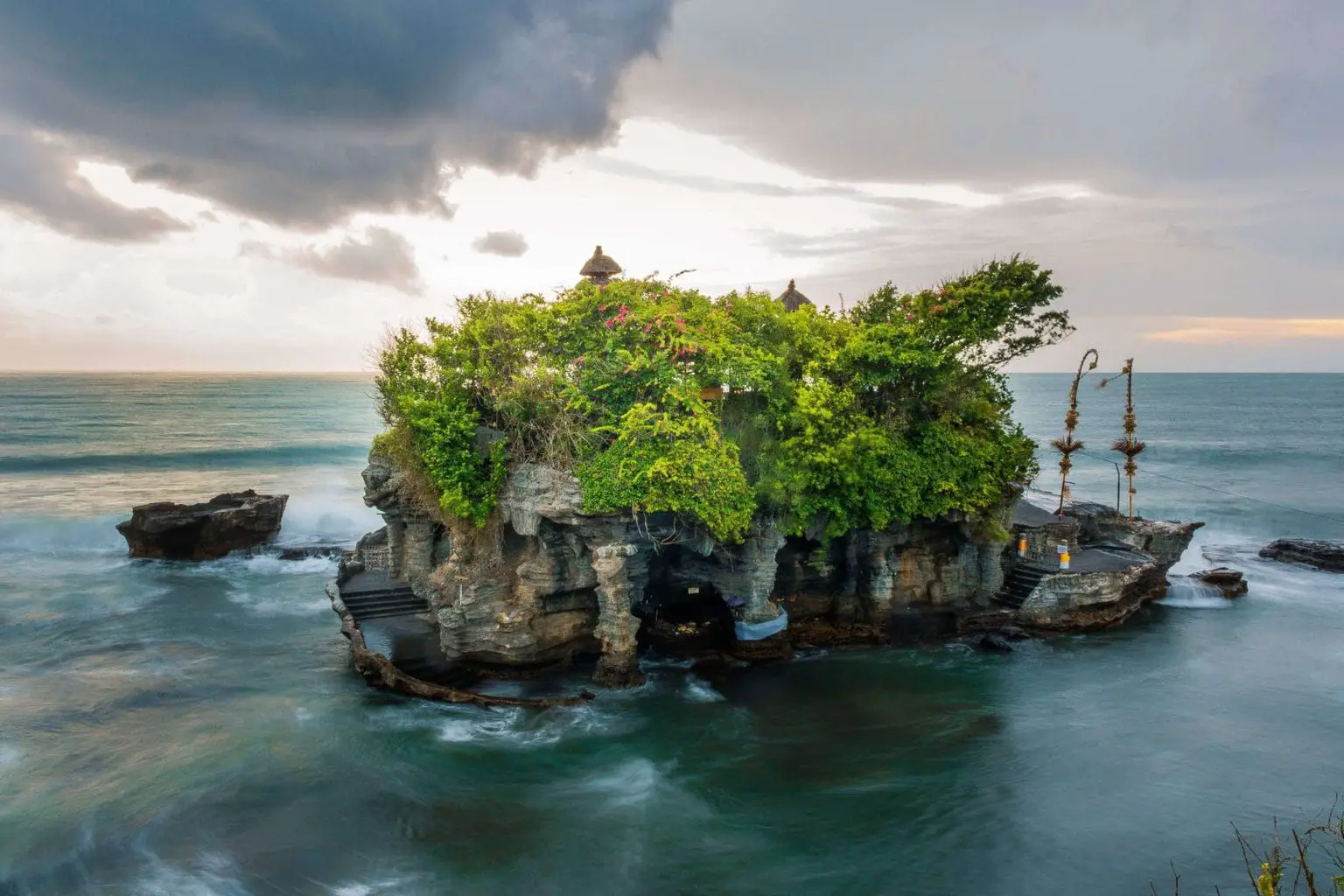
There are a lot of sacred places in Bali and Tanah Lot Temple is probably one of the most popular and visited locations among these temples.
The word ‘Tanah Lot’, in Balinese, means ‘land in the sea’ and the temple is a unique rock formation on the shore of the island. Tanah Lot Temple, along with the Uluwatu Temple, is one of the seven magnificent sea temples in Bali; it is featured heavily in Bali mythologies, the photogenic temple looks mesmerizing at every angle.
There are various spots in the surroundings to view the Tanah Lot Temple. Climb the cliff by the sea to have an overview of the temple and the dramatic waves, then walk through the gate and see the temple up close and personal. If you are staying in Bali for a few days, I’d suggest that you visit the temple at least twice, during the day and also before sunset! The waves hitting the rocks look breath-taking under sunlight, and the silhouette of the temple looks dreamy at sunset.
Mount Rinjani, Lombok
Explored by Michelle from Full Time Explorer
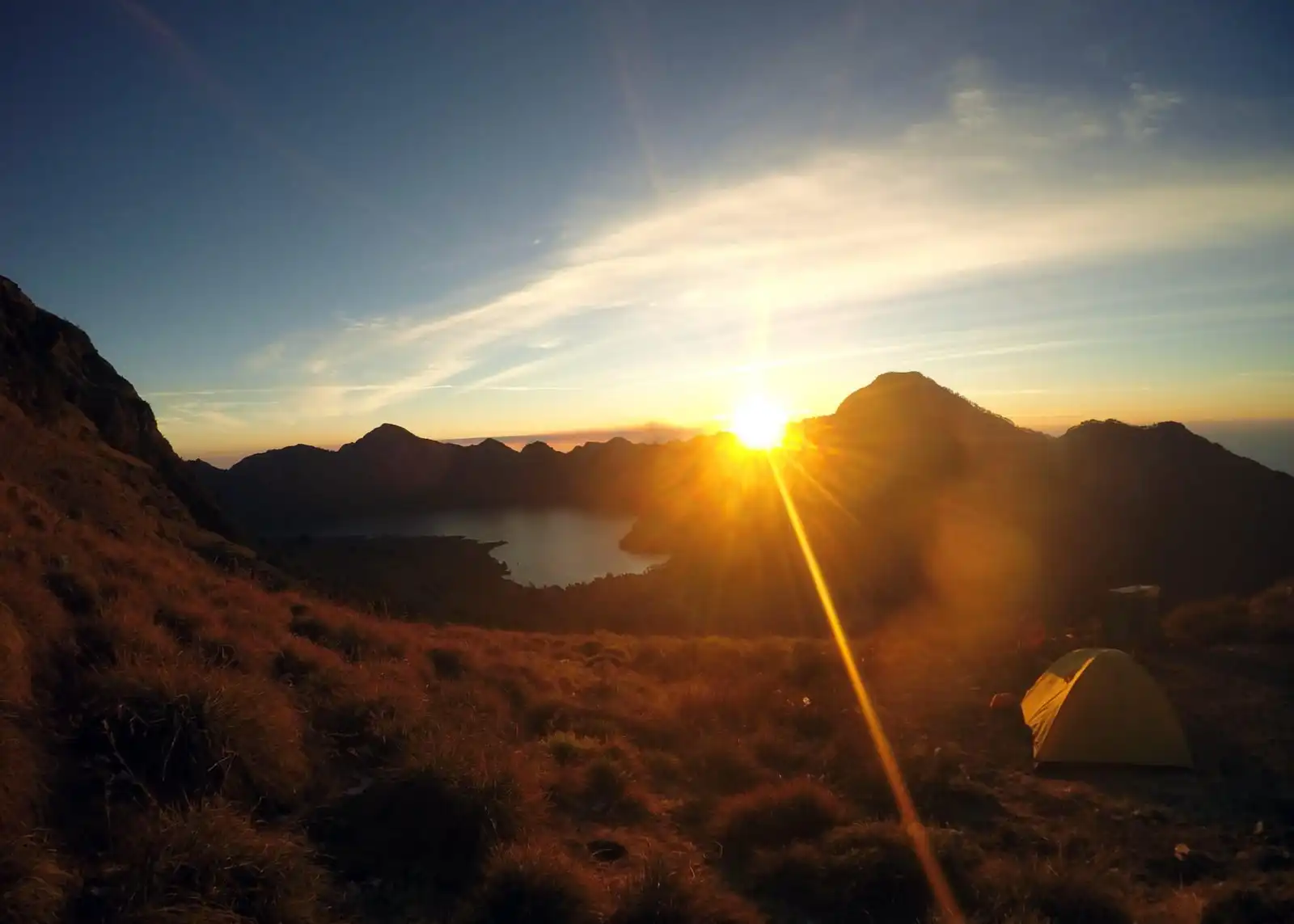
Mount Rinjani is an active volcano located on the island of Lombok in Indonesia. Reaching 12,224 feet (3,726 m) in altitude, it is the second highest volcano in the entire country (second only to Mount Kerinci).
Those who wish to visit can attempt to trek Mount Rinjani on a one or two-night camping trip. Although the trek can be done in as little as two days, it’s not for the faint of heart, and not everyone makes it to the top. From the crater rim to the summit is a grueling hike up volcanic ash which offers little traction beneath your feet. People have described it as a volcanic elliptical since every step forward sends you sliding backward.
It’s a true adventure to get to the top, but once you’re there, the views are worth the journey. From the summit, you can see all the way to Bali. Since much of this trek is done before the sunrise and there are very steep drop offs that can’t be seen at night, it’s best to book this trek with a guide who knows the path!
Prambanan Temple, Central Java
Explored by Lee at The Travel Scribes
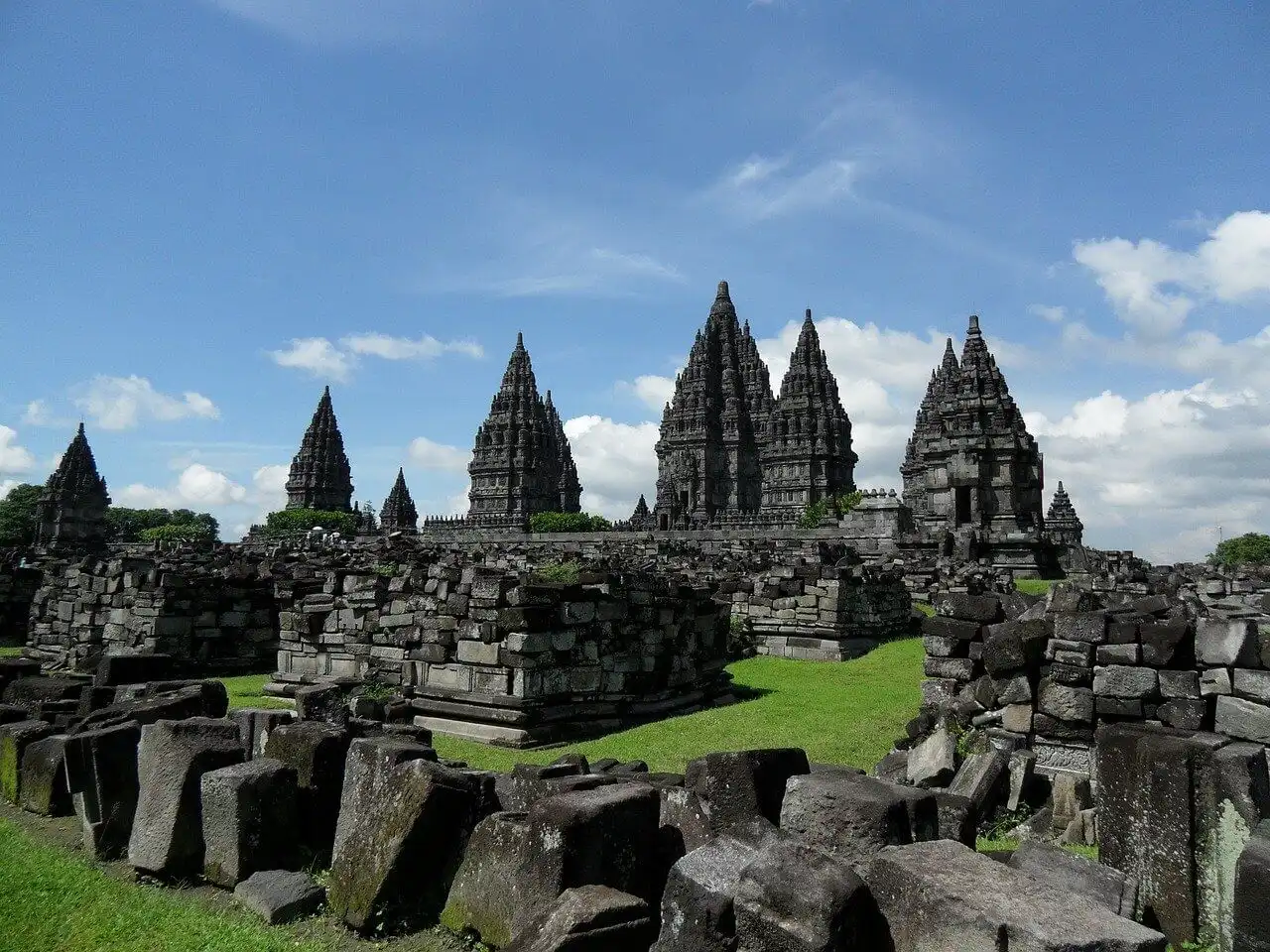
If Indonesia has the largest Buddhist monument in the world, it also doesn’t skimp on Hindu shrines. The best example is undoubtedly Prambanan Temple in Central Java, which is the largest Hindu temple complex in the country.
At the height of its might, the complex had 240 temples but, unfortunately, it fell into ruins and while the temples have mostly been restored, they still haven’t retained their heyday glory. The shrine is in honour of Shiva, the Hindu deity, and actually has two further shrines – Brahma and Vishnu – alongside it, which are almost just as magnificent.
This world heritage site reminded us a little of the spectacular Angkor Wat complex in nearby Cambodia but, unlike it, not much is known about the origins of Prambanan. It’s thought to have been built by Rakai Pikatan to celebrate the Hindu’s dominance in Java and then was abandoned when the Hindu-Javanese kings moved away.
Sacred Monkey Forest Sanctuary, Ubud, Bali
Explored by Justine from Wanderers of the World
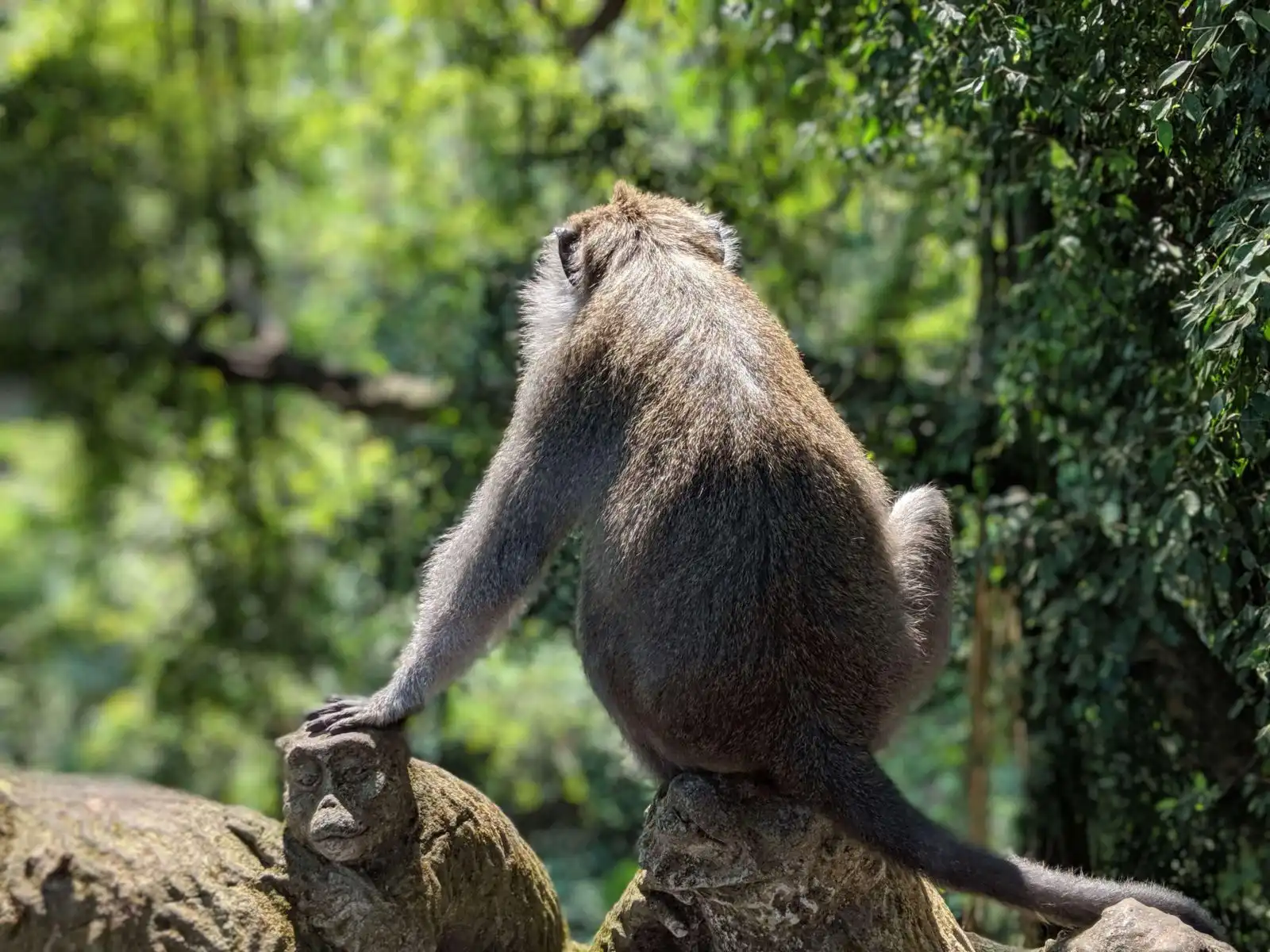
If Instagram, travel guides and YouTube videos are anything to go by, then the Sacred Monkey Forest Sanctuary (aka the Monkey Forest in Ubud) is most definitely an iconic place to visit in Indonesia.
Within the 12.5 hectares of forest in the village of Padangtegal in Bali, well over 600 Balinese long-tailed monkeys (or macaques) can be found alongside three Balinese temples from the 14th century.
Monkeys are central to the Hindu religion as Hanuman, the Hindu monkey god, is one of the most celebrated figures. The story goes that Hanuman once helped to rescue a Princess from the evil King Rahwana – and it’s this story that you’ll see being told through traditional Balinese Kecak dances.
Mythology aside, it’s a lot of fun to wander around the forest to watch the monkeys. During our visit, we saw a group of adolescent monkeys diving from the trees into a pond and another one trying to plug up a water fountain with leaves!
Top tips for your visit
- Keep an eye on your stuff! These cheeky monkeys love to steal anything from water bottles to tobacco. They’ll even go inside your bag if you let them.
- Quiet observation is key. If you keep your distance and watch the monkeys quietly from afar then you’ll have a great time and shouldn’t have anything stolen from you.
- Walk to the forest. It takes about 25 minutes to walk from the centre of Ubud to the forest, so save your taxi money for later!
Mount Sibayak, North Sumatra
Explored by Alex & Victoria from Northabroad
Have you ever climbed an active volcano?
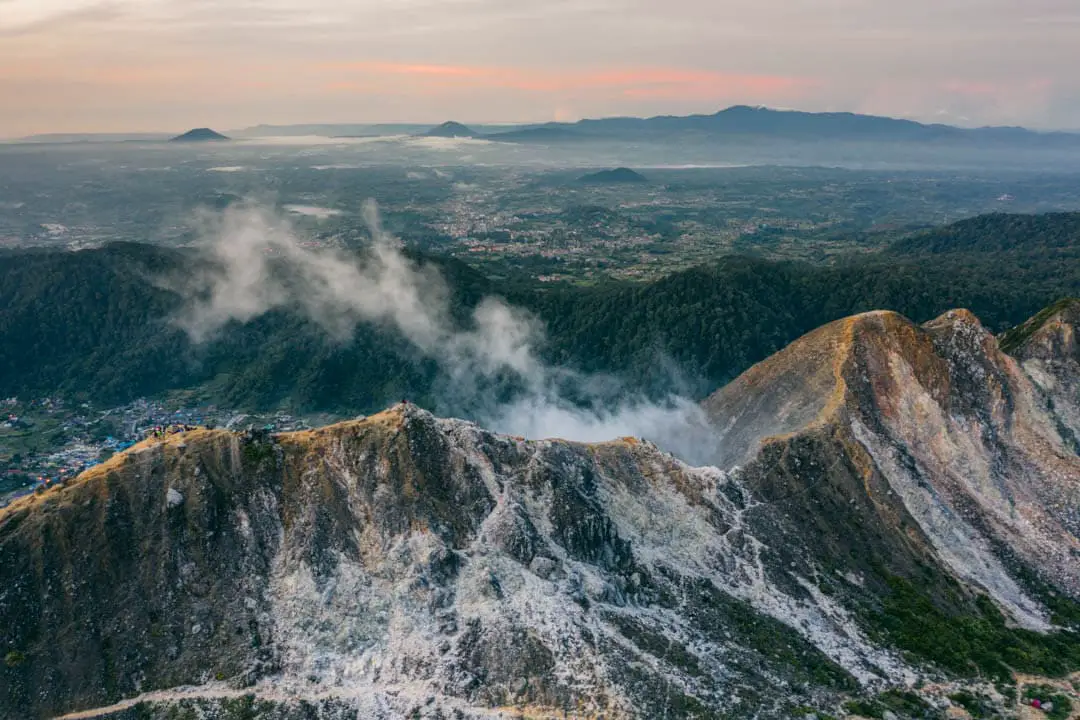
Well, if you find yourself in Sumatra you should definitely use the opportunity to trek Mount Sibayak (Gunung Sibayak). It’s in fact very active with steam vents coming out of the surface and you can smell the sulphur in the air. Don’t worry though, it’s not as active as its neighbouring volcano, Mount Sinabung, which is inaccessible due to its dangerous eruption patterns.
You can climb Mount Sibayak on your own but we wanted to go for sunrise so we hired a local guide to help us find the way. He picked us up at our guesthouse in Berastagi 4.30 in the morning and we drove to the start of the trail. The guide had no problem finding the right route even in the dark.
It’s uphill all the time and while it’s not an entirely easy trek it not that strenuous either. We reached the summit of the volcano about half an hour before sunrise and got ready for a spectacular sight. The colours were amazing! The sky was so clear that we could see the incredible Mount Sinabung in the distance.
Your best shot at good, clear weather is in the high season between June and August. Locals like to hike the volcano at weekends, so try to go on a weekday if you want the most serene experience. It’s a sunrise we will never forget!
Jatiluwih Rice Terraces, Bali
Explored by Stephanie from Let’s Venture Out
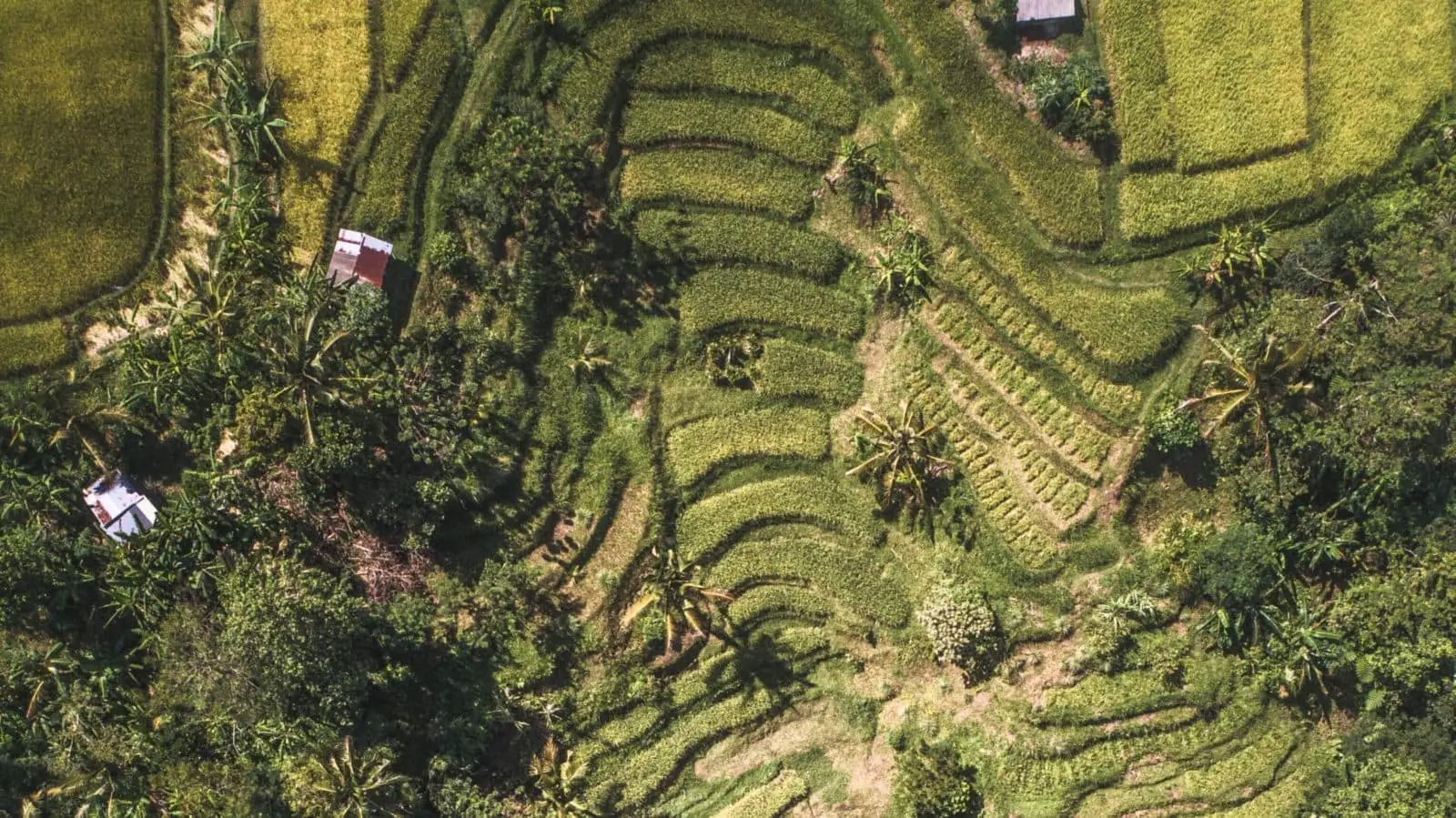
If you want to witness one of the most beautiful rice fields in Bali without the hordes of tourists, then the Jatiluwih rice terraces are right up your alley! Listed as a UNESCO World Heritage site thanks to its traditional and sustainable irrigation system called Subak, Jatiluwih’s cascading terraces will make you feel like you’ve just stepped into paradise!
You could spend hours and hours roaming around the 600 hectares of rice paddies and still not get bored! Every corner of Jatiluwih offers a unique vantage point and you may even spot Mount Agung on a clear day!
There are different hiking trails to choose from, ranging from 1.5 km to 5.5 km. The paths are well-marked, so you won’t need a guide to show you around.
The Jatiluwih rice terraces are located in central Bali, about 1.5 hours from Ubud or Canggu or 2 hours from Kuta. You can either hire a driver for about IDR 500k (36 USD/27.50 GBP) or rent a motorbike for IDR 60k (4.30 USD/3.30 GBP). The official opening hours are between 8.30 am and 6 pm.
Just before entering Jatiluwih village, you’ll find a checkpoint along the road where you can buy tickets for IDR 40k (2.85 USD/2.20 GBP). After a short scenic drive through the rice fields you’ll arrive at the information centre/entrance.
If you’re hungry, there are restaurants and cafés lining the side of the road at the entrance and a few stalls selling Balinese food and fresh coconuts inside the rice terraces.
Belitung Lighthouse, Lengkuas Island
Explored by Jub from Tiki Touring Kiwi
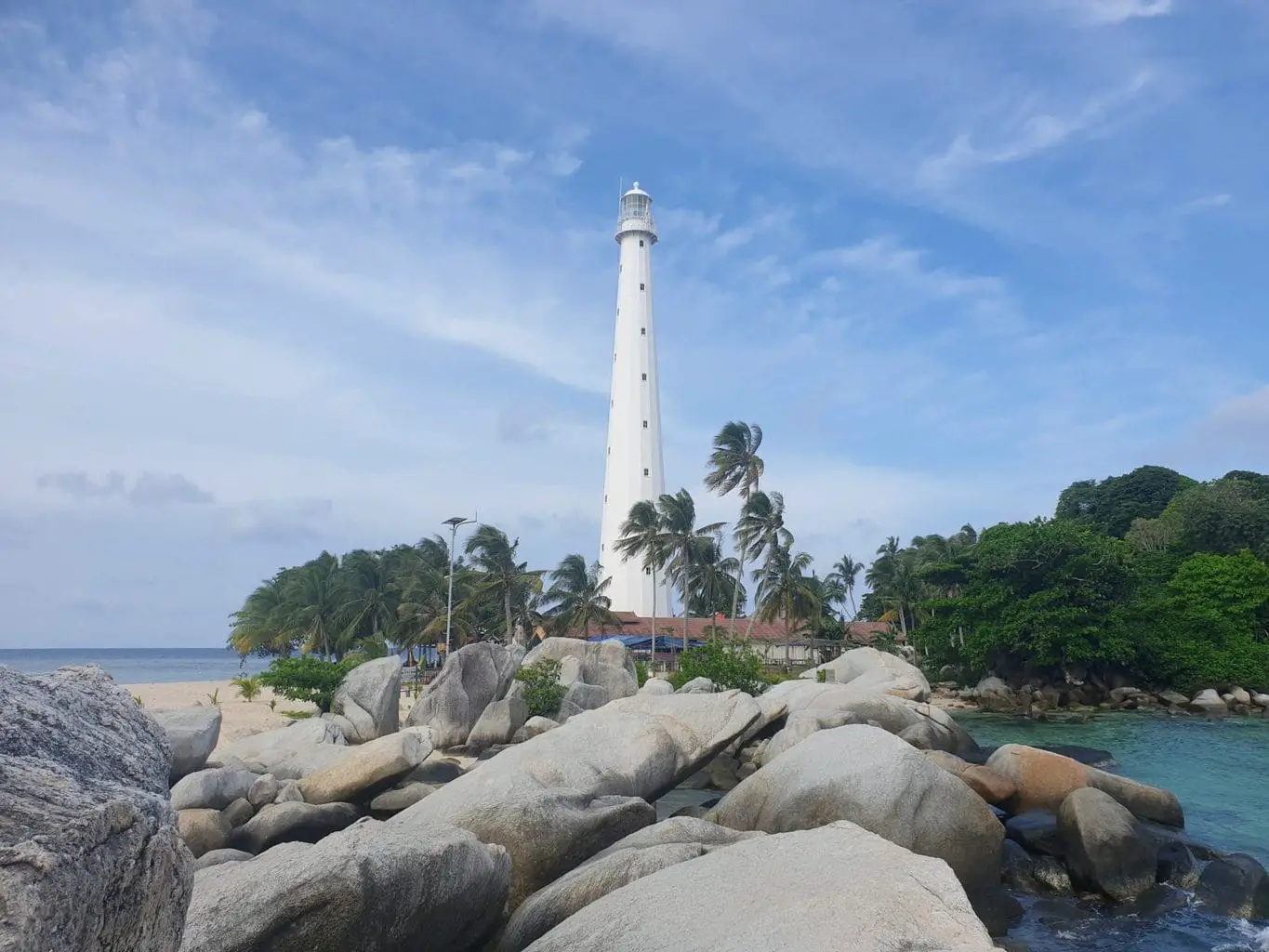
Belitung, located between Singapore and Jakarta is a large island that is just starting to get noticed by international tourism after flights from Singapore started there in 2018. Of all the attractions in Belitung, the most iconic view is of the lighthouse on Lengkuas Island, a short boat ride from Tanjung Kelayang.
The lighthouse was built in 1882 when the country was a Dutch colony. To this day the lighthouse is still working, but that doesn’t stop visitors to the island being allowed to walk to the platform on the 12th floor. So while the views from around the island of the lighthouse are picturesque, the views from the top of the lighthouse give visitors a chance to see the coastline they’ve just driven through via boat.
Jam Gadang, West Sumatra
Explored by James from The Travel Scribes
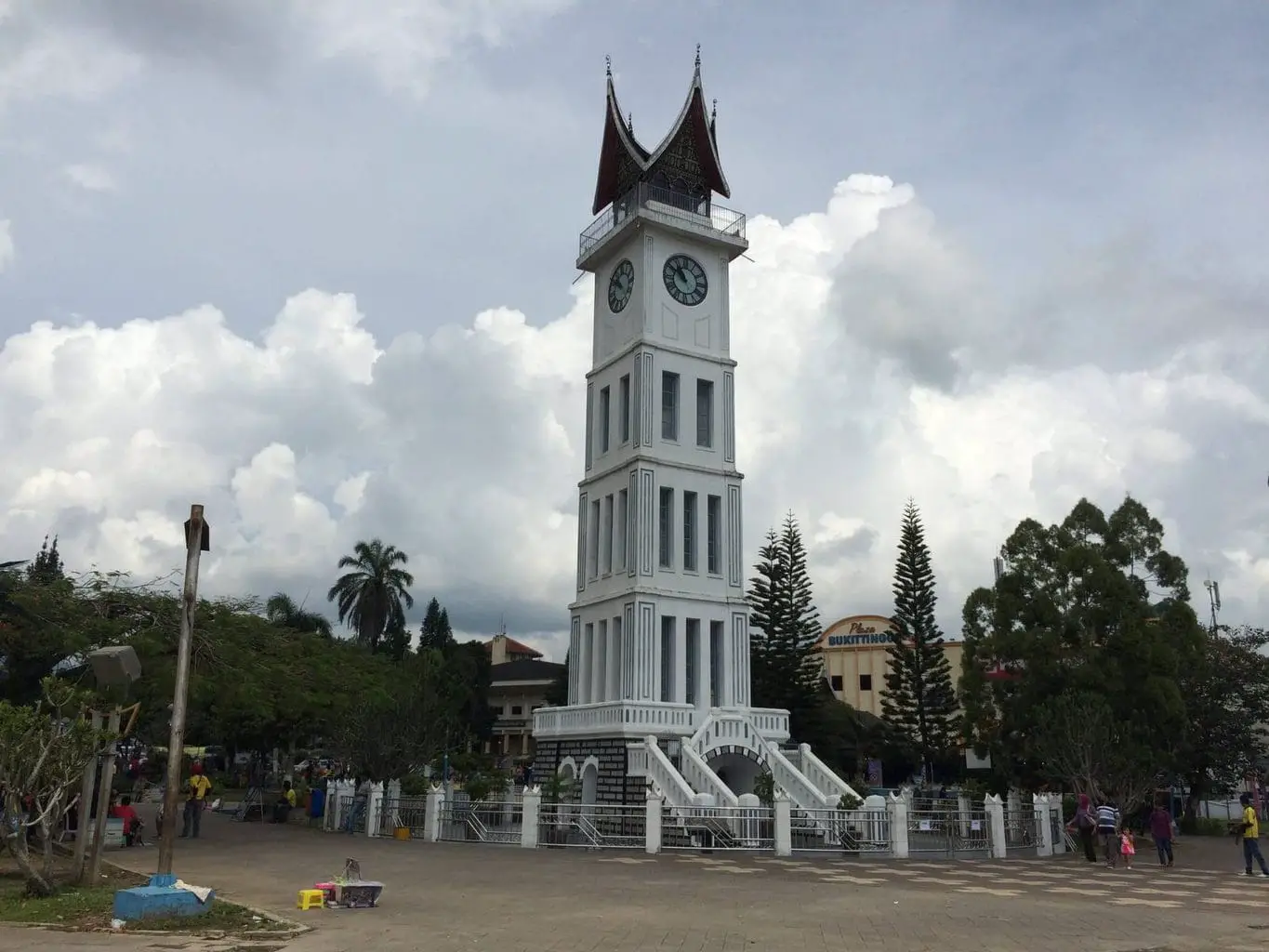
Photo courtesy of Kars Alfrink / Flickr
Move over Big Ben, Indonesia has its own renowned Clock Tower, the Jam Gadang!
This major landmark in the city of Bukittinggi was built back in 1926, when the Dutch occupied Indonesia. And, actually, it’s not just one clock but four of them, made in Germany and shipped via Rotterdam to Indonesia. The towering white-washed clock tower used to have a rooster atop it but this was replaced by a Shinto ornament during the Japanese occupation of the town.
It’s handily located in the city centre near the Ateh market and in the middle of the Sabai Nan Aluih Park. That means you can stroll around to do some shopping and pick up a few souvenirs, particularly ones of the clock tower itself!
Did you know? The clocks use III for the number four instead of the more accepted Roman numeral IV. According to legend, it’s since four workers died during the construction of the building although another tale says that it’s since the Dutch wanted to avoid rumours that IV stood for Dutch victory.
Rumah Pohon Treehouse, Nusa Penida
Explored by Nick from the Wandering Wheatleys
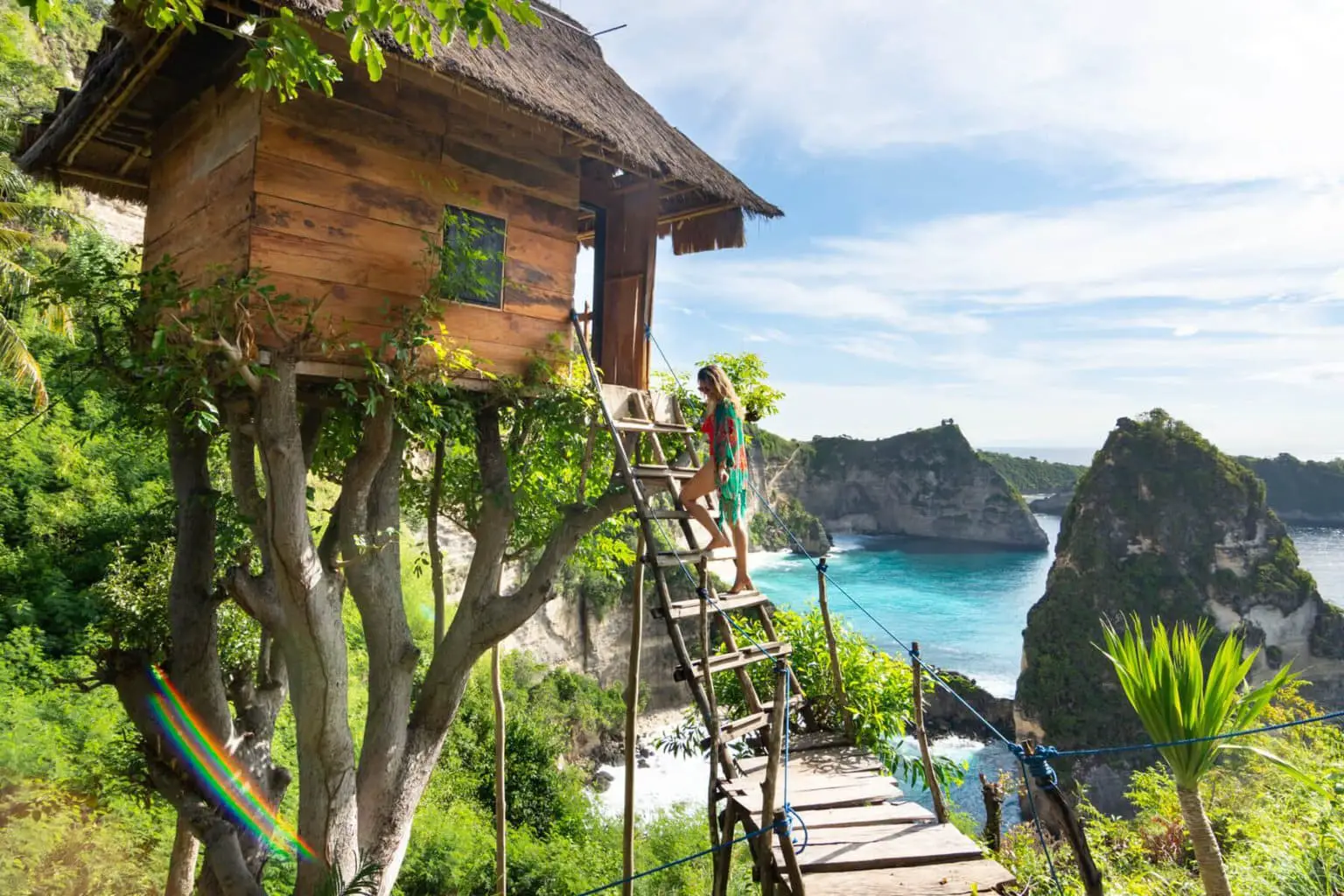
The most unique place you can stay on the island of Nusa Penida, the Rumah Pohon Treehouse, has achieved Instagram fame thanks to its stunning location and rustic construction.
Perched high on a cliff overlooking Diamond Beach, this tiny treehouse doesn’t offer many amenities. In fact, it’s just big enough for a double bed and a fan. You’ll also have to share an outdoor bathroom with two other nearby treehouses. But what it doesn’t offer in the way of luxury it makes up for with one of the best views on Nusa Penida.
You have undoubtedly seen photos of Instagram influencers climbing the stairs up to this treehouse for a perfect photo. However, it’s unlikely that they actually stayed there. Most people simply visit the Rumah Pohon treehouse to admire the panoramic views and snap a couple of photos.
It’s easy to find it on Google Maps – the small peninsula it sits on is marked as “Thousand Island Viewpoint”. Just park at the top of the hill and pay the entrance fee of 10,000 IDR (0.55 GBP/0.75 USD) before hiking down the steep trail to the viewpoint and treehouses.
The treehouse books up 2 to 3 months in advance and costs $40 per night. You can find it listed here if you want to check rates and availability.
Ampera Bridge, South Sumatra
Explored by Lee from The Travel Scribes
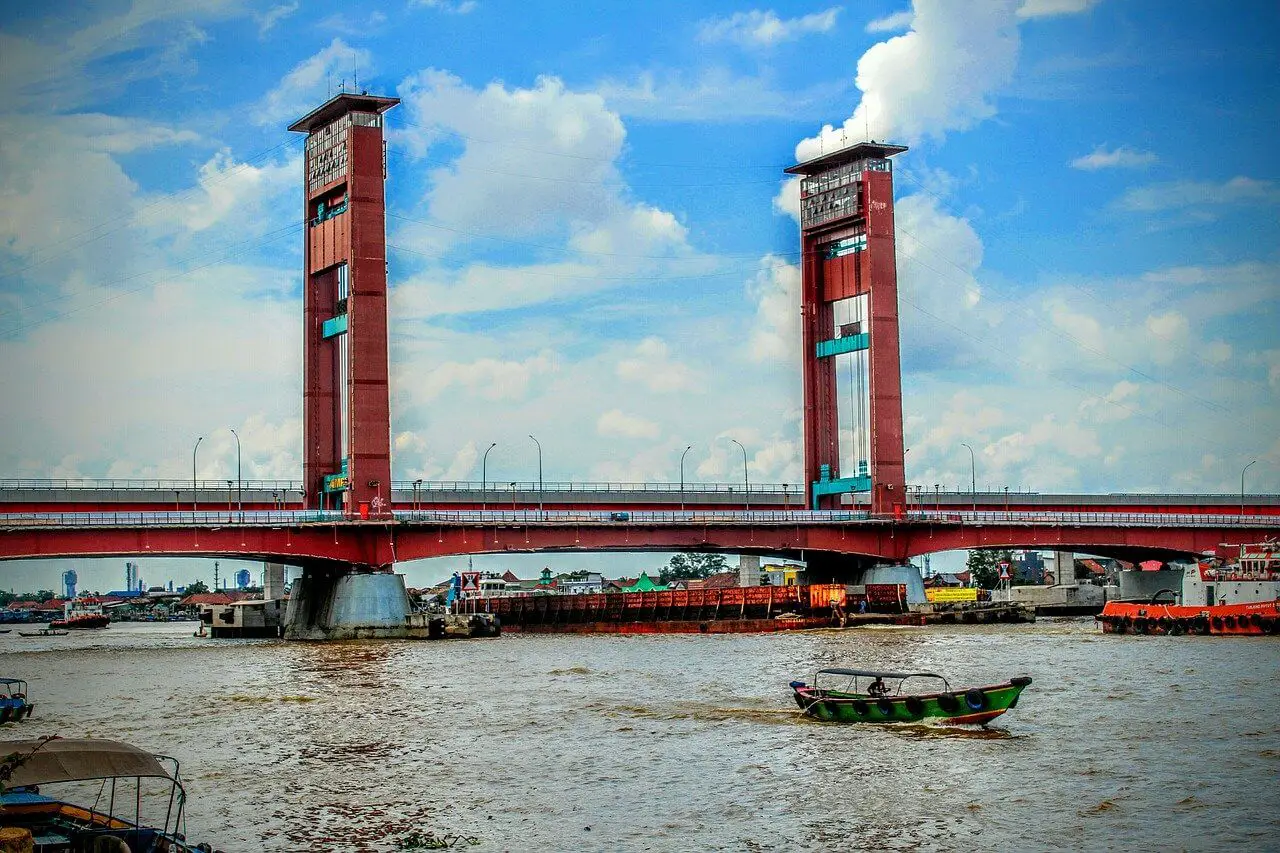
It reminds us a little of the Golden Gate Bridge in San Francisco but the Ampera Bridge, located in Palembang, South Sumatra, is an attempt to mimic London’s Tower Bridge, commissioned by Indonesia’s first president, Bung Karno. It gives us visions of San Francisco since it is also painted in the same fire engine red hues, although apparently this is its third colour coating – the bridge was originally grey and then later yellow.
The bridge, officially opened in 1965, connects two regions of Palembang, Seberang Ulu and Seberang Ilir, over the Musi River. This 75 metre long bridge is a vertical lift bridge, meaning that the centre of the bridge lifts up to allow tall ships to pass through.
Did you know? The Ampera Bridge was originally named Bung Karno Bridge after the president. It was renamed after his fall.
Kelingking Beach, Nusa Penida
Explored by Leah from Officer Travels
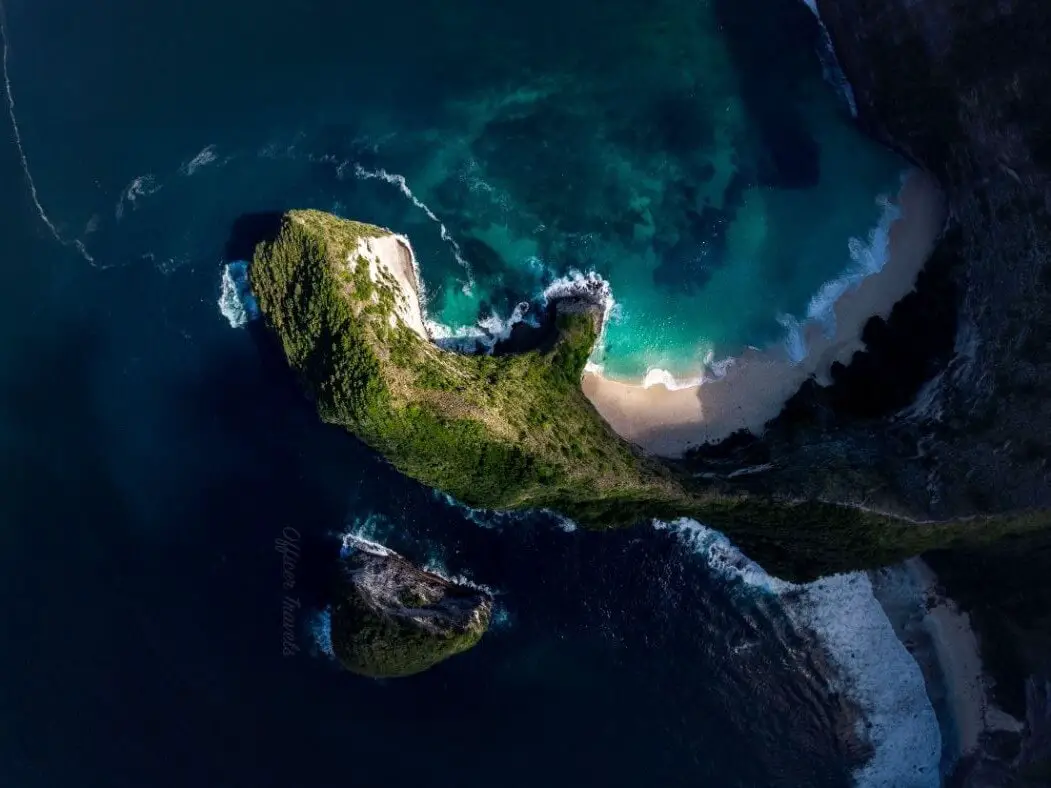
We’ve all seen this iconic beach by now so visiting this magical cliff will already be at the top of your Indonesia Bucket list. If it isn’t, it should be. Not only is the view from the top of the cliff spectacular, but you can also walk down its ‘spine’ to the secluded bay where pods of Manta Ray have been known to visit, making it a great spot for cooling off with a bit of snorkelling.
Kelingking Beach is located on the small island of Nusa Penida, a place that can only be accessed by boat from a handful of nearby locations. A way to save a few pennies on transport is to hitch a ride with the local water taxi, instead of paying big for the more comfortable tourist ferry. This is a lot cheaper and an experience in and of itself and one we’re pleased we had.
There are two ways of reaching Kelingking Beach from the docks. Either with a driver or on your own bike – both are a lot cheaper if booked from the mainland. Be warned though, due to the nature of the roads this isn’t the place for learning how to ride.
Thanks to the recent boom in tourism since 2018, accommodation is more widely available on Nusa Penida now, making it a viable option for longer visits but you will still need a form of transportation to get around the Island as footpaths and roads are still being built.
Mount Bromo, East Java
Explored by Wendy from The Nomadic Vegan
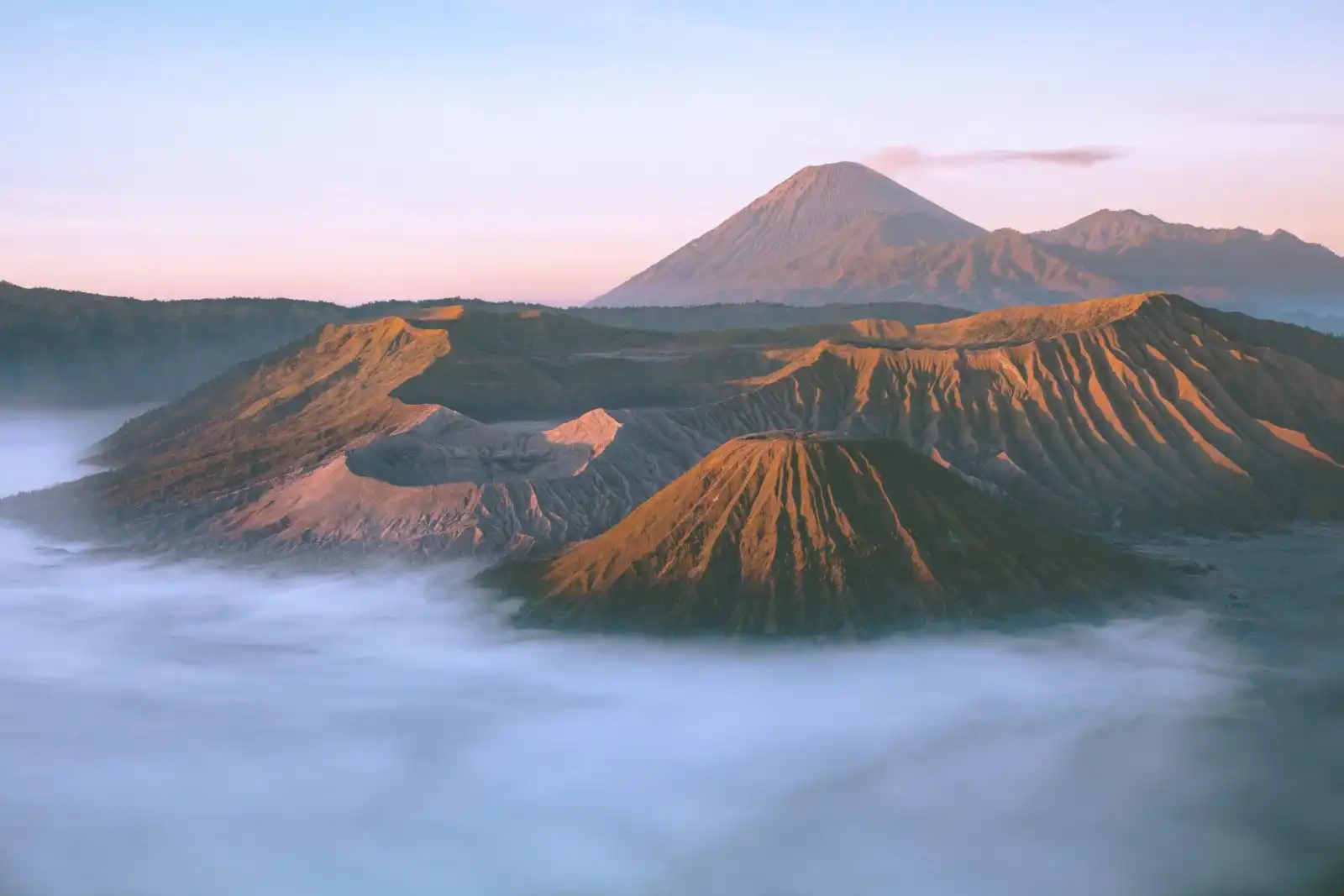
Mount Bromo is a collapsed but still smouldering volcano that lies within an otherworldly moonscape called the Sea of Sand. This whole volcanic landscape is protected as part of the Bromo Tengger Semeru National Park.
There are a number of guesthouses near the park that offer lodging and basic Indonesian food. All of them can arrange sunrise visits to the park, which is by far the most popular time to visit. These tours typically start with a visit to the viewpoint for the iconic sunrise shot of Mount Bromo surrounded by the Sea of Sand with the very active Mount Semeru blowing out smoke in the background. This is one of the most well-known images of Indonesia. Be prepared to share the experience with lots of other tourists.
After the sunrise, you then have the chance to climb down to the edge of the crater itself and stare down into the abyss below. Be warned, the sulphurous fumes emitted by Mount Bromo are incredibly stinky! Bring a handkerchief or bandana to cover your nose and mouth. At times when Bromo is particularly active, the caldera area may be off-limits for tourists’ safety.
Tana Toraja, Sulawesi
Explored by James from The Travel Scribes
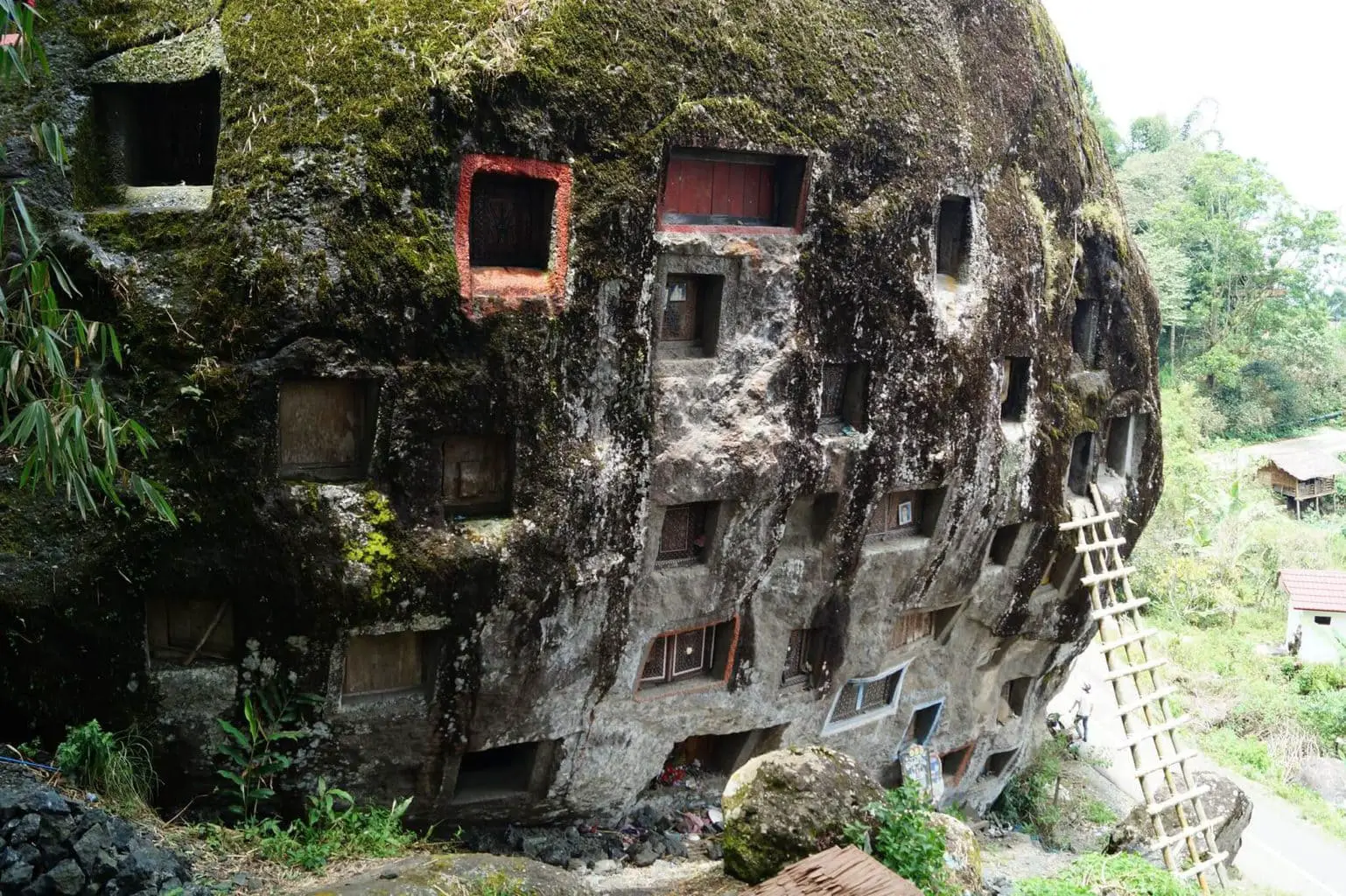
Photo courtesy of Niek van Son / Flickr
It’s not necessarily a ‘landmark’, but the area of Tana Toraja is a pretty famous place in Indonesia, and somewhere to visit if you have the time. Situated on the island of Sulawesi, the area is situated amidst towering mountains and is the home of the Tarajans; whose very detailed burial rituals have attracted visitors from far afield.
The burial rituals include ‘cave graves’ in each village, and people often visit the one in Londa, as well as the cliff cemeteries of Lemo. The rituals themselves are a little grisly – after someone’s death the body is stored while the family saves money for the ceremony, called ‘tomate’; this can take years to do! During the funeral festival which can last as long as a week, buffaloes and pigs are slaughtered, as well as ritual dances performed until the person is stored in a small cave or in a hollow tree.
More than just gruesome funerals, the homes in Tana Toraja are quite special, in that their unique-looking houses have roofs that look like boats!
Mount Ijen, East Java
Explored by Una from Wandernity
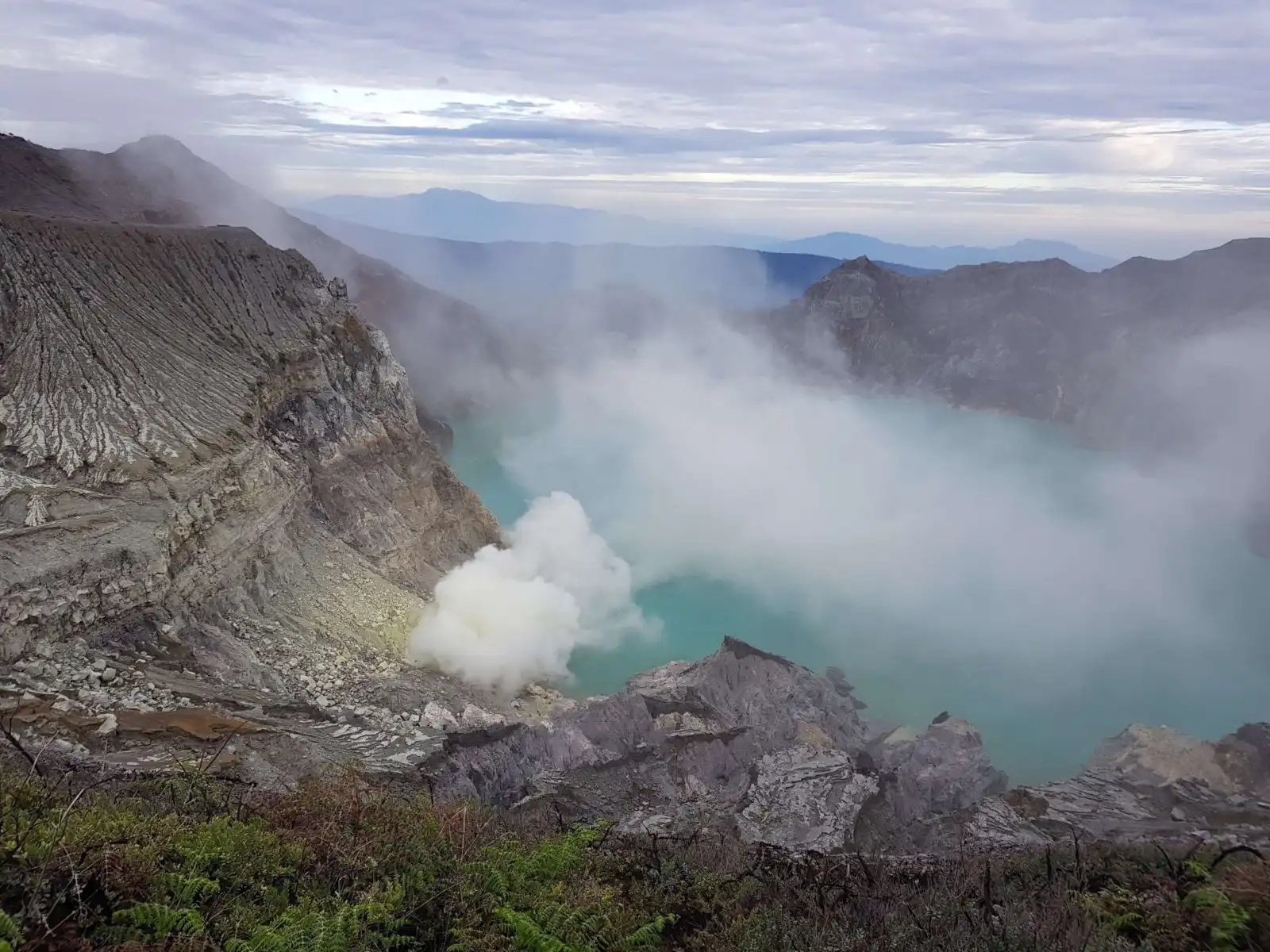
Ijen volcano on Java might be one of the most beautiful places to visit and photograph. There are several options on how to hike the volcano, but one of the most popular is to climb up at night.The night tours start in a timely manner around 1 am, as Ijen offers much more to see then just waiting for the sunrise at the top.
It takes around 1.5 hours to get to the top of the volcano. The most interesting part starts after that, as it’s possible to climb in the crater. During the night time, it is hard to see the magical colours of the one-kilometre-wide turquoise-coloured acidic crater lake. But It’s impossible to avoid the sulphur smoke coming up from the crater, where sulphur mining takes place. On the way in the crater, there are many miners hand-carrying sulphur-laden baskets.
Near the surface of the crater lake electric-blue flame of Ijen can be observed. It’s caused by ignited sulfuric gas and is the largest blue flame area in the world.
After watching the flame and trying to dodge the sulphur smoke on the path, the hike leads back up to the top of the volcano for the sunrise watching.
Many people wait for the sunset at the starting point of the path down in the crater. However, it’s possible to go around the crater edge and find a spot without other tourists. Going further around the crater you’ll find some burnt trees, which create out-of-this-world views, especially when the first rays of sunshine pour over the blue lake and illuminate the surrounding volcanos.
Uluwatu Temple, Bali
Explored by Natalie from Love and Road
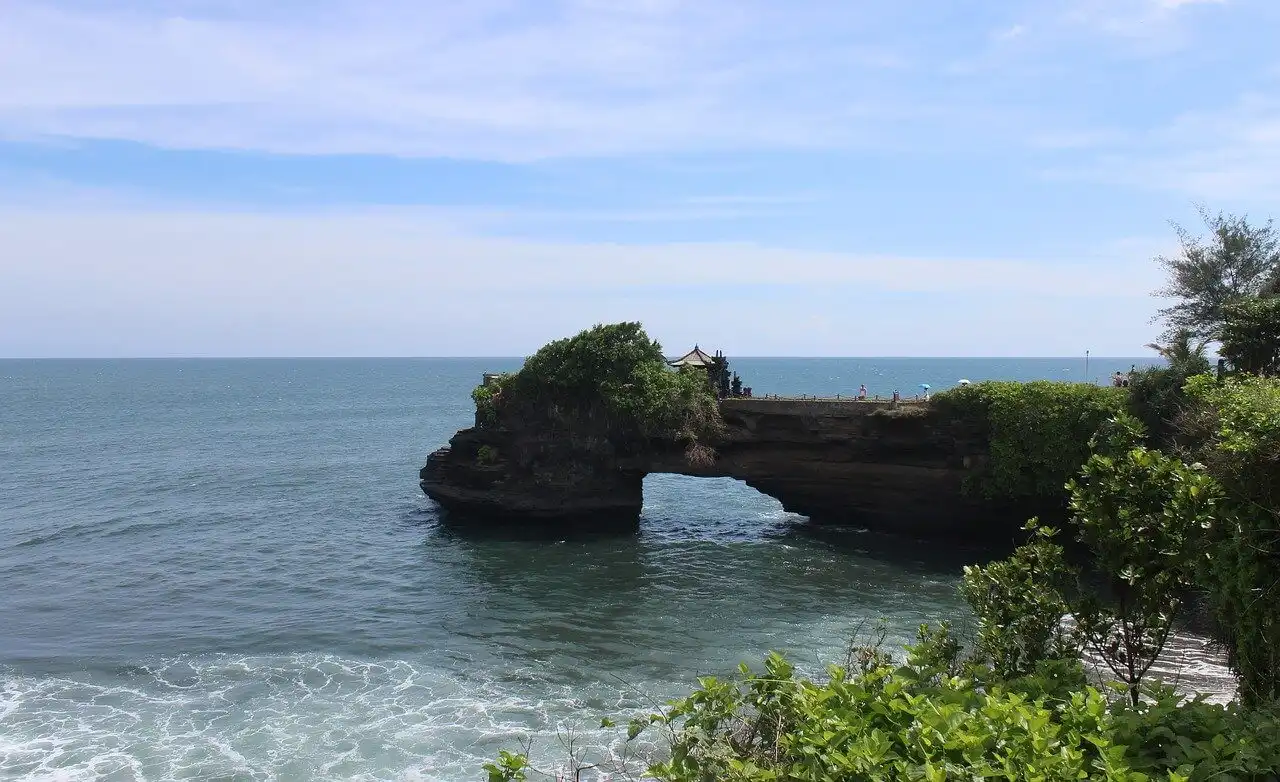
Uluwatu Temple or Pura Luhur in Balinese is one of the most beautiful temples in Bali, and it’s easy to understand why. The temple was built at the edge of a cliff, 70 meters high, and the views you have from there are spectacular. It’s located in Uluwatu, South Kuta – Bandung, and it’s one of the iconic places on the island that every traveller must visit. The complex is stunning with intricated details and decoration, and the nature surrounding it is breath-taking. Add to this mix a marvellous sunset and a cultural dance, and you have the perfect activity for a sunset session in Bali.
The Kecak Dance is performed at the temple every day at 6 pm. The dance has roots in the Hindu religion, and it’s a unique show with beautiful costumes, fire, and all the music during the presentation is vocalized by the performers. It’s a must-see.
The Uluwatu Temple and Kecak Dance are some of the top things to do in Bali, so be prepared to arrive early to avoid queues and get a good seat. My recommendation is to come at least 1 hour before the show so you can visit the complex (that is huge) and find your way to the arena where the show happens. Side note, traffic in Bali is terrible, so plan your trip to Uluwatu accordingly, there are a lot of buses, vans, and taxis going that way before sunset. If you know how to drive a scooter, you can rent one and drive there. It’s the easiest and fastest way.
One more tip, keep an eye on the monkeys, the park that surrounds the temple is packed with them, and they are nasty. Everything that shines is an invitation to be stolen, so put your water bottles inside the bag, mind your sunglasses, cameras, phones, and tablets. You might be able to trade them back with fruits, but I saw a few people losing the phones for good. Don’t take the risk.
Ratenggaro Village, Sumba
Explored by Daniele & Elena from Cycloscope.net
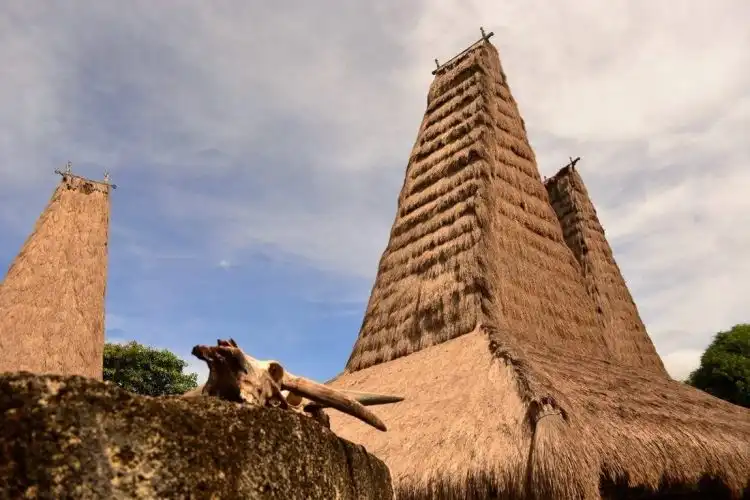
Set on the southwest pristine shores of one of the wildest islands in Indonesia, Ratenggaro is a portal to another dimension. This wave-battered village in Sumba features an architectural style unique the Merapu, one of the last few megalithic cultures of the Planet.
Houses aren’t made of big slabs of stone, as those are reserved to the tombs of chiefs and heroes of the Pasola. The Merapu people living quarters are instead bamboo construction topped by humongous thatched roofs, about 40 meters tall.
Sumba is a quite an off-beat destination in Indonesia, but totally worth the effort required to reach it.
The island is surrounded by white sand beaches and crystal-clear waters, gets very few tourists and has one of the best resorts in the world, it’s a great place for a cycling adventure in Indonesia, and I could go on with more incredible attractions – but it’s most powerful spell is for sure its unique cultural villages, and Ratenggaro is probably the most impressive.
One last tip, get there for the Pasola season… or at least don’t miss the sunset from the village.
So that makes up our list of iconic landmarks in Indonesia, but let us know in the comments below or drop us an email here, if you think that there are other famous landmarks that we’ve missed and should add into this list!
Are you interested in other amazing landmarks in Asia? Check out some of the iconic places that we’ve explored:
- 21 Iconic building and landmarks in Singapore
- Famous places in Myanmar
- Most iconic buildings and landmarks in Vietnam
- Thailand’s 21 most iconic places
- Iconic places and famous landmarks in Malaysia
- The top 10 landmarks in China!
What camera equipment and other gear do we use?
We’re living proof that you don’t need the most expensive gear to travel the world and take good photos. Here are some of our must have items that make it into the packing list for all our travels.
- Main Camera: Panasonic Lumix FZ1000
- Drone: DJI Mavic Air – Fly More Combo
- GoPro: Hero 7 Black
- GoPro Dive Case: Go Pro Housing
- GoPro Case: Smatree GoPro Carry Case – Small
- Packing Cubes: Eagle Creek Packing case
- Backpack: Osprey Farpoint 70
- Powerbank: Anker Powercore
- Phone: Xiaomi Mi 9
- Hard drive: Transcend Slim Storejet 2TB
- Laptop: Lenovo IdeaPad 720s
- Headphones: Bose Quiet Comfort 35
- Wifi Hotspot: GlocalMe G4
Want to save this for later? Why not pin it…
